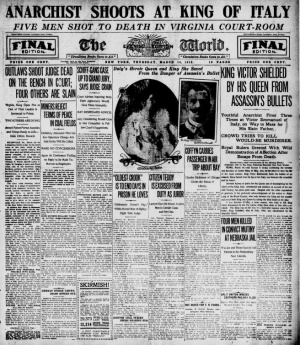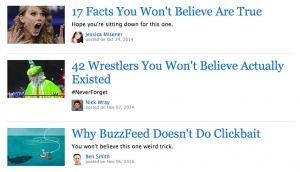Difference between revisions of "Clickbait"
| Line 1: | Line 1: | ||
[[File:Clickbait6.jpg|thumbnail|Examples of clickbait headlines on the side of a website.]] | [[File:Clickbait6.jpg|thumbnail|Examples of clickbait headlines on the side of a website.]] | ||
| − | '''Clickbait''' refers to web content designed to entice its readers into clicking an accompanying link. | + | '''Clickbait''' refers to web content designed to entice its readers into clicking an accompanying link. Josh Benton of Harvard’s Neiman Journalism Lab defined clickbait more colloquially as "noun: things I don't like on the Internet,” which demonstrates the often negative connotation associated with the term. <ref> It's Everywhere, the Clickbait https://www.theatlantic.com/entertainment/archive/2014/11/clickbait-what-is/382545/ </ref> Clickbait frequently appears in journalism and social media sites in the form of short teaser messages or images designed to attract attention. Its primary goal is to generate advertisement revenue especially through striking images and enticing headlines.<ref name="pot">Potthast, Martin; Köpsel, Sebatian; Stein, Benno; Hagen, Matthias (2016). ClickBait Detection Bauhaus-Universität Weimer</ref> Clickbait often encourages users to click on a link by withholding certain information about the article it links to. Often the landing pages of such links are composed of [[Fake News | fake news]] or opinion pieces without supporting research or evidence.<ref name="TWP">The Washington Post website: "What is ‘click bait’ and why Facebook wants to display less of it" https://www.washingtonpost.com/news/technology/wp/2014/08/26/what-is-click-bait-and-why-facebook-wants-to-display-less-of-it/?utm_term=.eccfff2e28b8</ref><ref >Tech Crunch: "*** is a clickbait "https://techcrunch.com/2016/09/25/wtf-is-clickbait/"</ref> Clickbait headlines are intriguing and bring readers in just enough to want to click on the link. Because online media outlets rely heavily on page views to generate ad revenue, clickbait is often used to artificially inflate ad impressions. <ref name="ch"> Chakraborty, Abhijnan; Paranjape, Bhargavi; Kakarla, Sourya; Ganguly, Niloy (2016). Stop Clickbait: Detecting and Preventing Clickbaits in Online News Media Cornell University Library</ref><ref >The dirty secrets of clickbait. This post will blow your mind! "https://econsultancy.com/blog/64399-the-dirty-secrets-of-clickbait-this-post-will-blow-your-mind/"</ref> Mainstream usage of clickbait has been criticized for misleading users and lowering quality standards in journalism. |
==History== | ==History== | ||
Revision as of 22:16, 28 March 2018
Clickbait refers to web content designed to entice its readers into clicking an accompanying link. Josh Benton of Harvard’s Neiman Journalism Lab defined clickbait more colloquially as "noun: things I don't like on the Internet,” which demonstrates the often negative connotation associated with the term. [1] Clickbait frequently appears in journalism and social media sites in the form of short teaser messages or images designed to attract attention. Its primary goal is to generate advertisement revenue especially through striking images and enticing headlines.[2] Clickbait often encourages users to click on a link by withholding certain information about the article it links to. Often the landing pages of such links are composed of fake news or opinion pieces without supporting research or evidence.[3][4] Clickbait headlines are intriguing and bring readers in just enough to want to click on the link. Because online media outlets rely heavily on page views to generate ad revenue, clickbait is often used to artificially inflate ad impressions. [5][6] Mainstream usage of clickbait has been criticized for misleading users and lowering quality standards in journalism.
History

Prior to the term clickbait being used, sensationalist headlines were used to amass an audience as early as the 19th century, where political cartoons were displayed to attract the attention of the readers. Similar tactics were also present in early 19th century journalism where provocative newspaper headlines competed for attention. [7] The emergence of clickbait in tabloid journalism [5] as well as its success in rousing interest have put pressure on legacy media due to competition for readers and revenue.[8] Many research studies have been conducted to understand the psychological appeal of clickbait, leading to empirical methods for identifying it.
Backlash
In response to the spread of clickbait, Facebook has made efforts to improve news feed algorithms to "help people find the posts and links from publishers that are most interesting and relevant, and to continue to weed out stories that people frequently tell us are spammy and that they don’t want to see".[3] Facebook has attempted to remove clickbait by measuring the click-to-share ratio of links[5], identifying phrases that are commonly used in clickbait headlines,[9] [10] and identifying clickbait by measuring the amount of time that the user spend on the website after clicking the link. [3] Other scholars have also developed clickbait detection models and extensions to further help decrease how often they appear[2][5] as well as developing tools for analyzing news sources in order to distinguish real and fake news. [11]
YouTube
In order to combat clickbait thumbnails and video titles, YouTube has incentivized content creators to accumulate watch time rather than views. An editor from DIY Musician explains that, "Because YouTube view counts can be so easily gamed by misleading thumbnails... YouTube now measures the total amount of time a viewer watches your video (and any videos they watch after your video)." [12]
Types
Exaggeration
Extreme exaggeration of what the content on the landing page will be.
Example: Cringeworthy tattoos that will destroy your faith in humanity
Teasing
Omission of important details from title to build suspense.
Example: “Here’s Why Hillary Clinton Is ‘Deeply Worried’ About The UN’s Damning Climate Report”
Inflammatory
Usage of inappropriate/vulgar words and misleading phrasing.
Example: Putin Punched at G20 Summit.
Formatting
Overuse of capitalization/punctuation, particularly ALL CAPS or exclamation points.
Example: EXCLUSIVE: Top-Secret Method allowed a mother to break the world record: 12kg in 4 weeks!
Graphic
Salacious, disturbing, overly descriptive, or unbelievable subject matter.
Example: Donatella Versace plastic surgery overload: Waxy face resembles melting candle.
Bait-and-switch
Title that lies about content promised/implied to be in the landing page/article; often requires additional clicks to find intended information or is completely missing from article.
Example: Beers Americans No Longer Drink.
Ambiguous
Unclear or confusing title to spur curiosity.
Example: Hands on: Samsung’s iPhone 5 is absolutely beautiful.
Wrong
Factually incorrect article title.
Example: Scientist Confesses: “Global Warming a $22 Billion Scam/center"
Hubris
Articles that entice by challenging intelligence
Example: Can you solve this easy riddle? 95% of people get it wrong!
Ethical concerns
Clickbait headlines typically aim to "exploit a “curiosity gap” by providing just enough information to make a reader curious, but not enough to satisfy that curiosity".[13][14] The headlines are aimed at altering the emotions of the user, and if they fall for a clickbait it often leads to negative experiences. The presence of clickbaits in social media are also creating an increase in fake news where large proportions of social media users are uneducated on how to distinguish fake news sources from genuine news sources, which in turn create filter bubbles of misinformed users.
Negative experiences
Negative experiences are created when the user encounters a clickbait and has high expectations than what the article contains.[15][16]. Clickbaits rely on emotions to attract viewers and often create headlines that cause anger, anxiety, humor, excitement, inspiration, or surprise.[17] Upon visiting the article, many people are disappointed because they are often grammatically incorrect and the content found inside does not correspond to the title. Clickbaits can also lead to frustration because of their rate of occurrence on news feeds.
Fake news and misinformed users
Main article: Fake News
People are now using social media as their only way of acquiring news and many people do not know how to adequately identify genuine news sources [18] making them vulnerable to believing clickbaits when they encounter one. Clickbait often take bits of true stories but insinuate and make up other details to make the users react to them and their success is due to the large amounts of views and shares they receive. Clickbait are hard often hard to distinguish from real news sources because their format is manipulated to resemble credible journalism. Clickbait are notorious for spreading misinformation[19] and if users believe the content of the clickbait chances are they are going to share it with their own network. This further popularizes the clickbait and presents it to a larger number of users who could do the same, creating filter bubbles of misinformed users [20] who are often not educated on how to distinguish fake from real news sources.
Some sites dedicate themselves to sharing blatantly fake news stories, like The Onion[21] and ClickHole[22]. These sites are satirical, but neither of their home pages are clearly marked as such. Their headlines are notorious for clickbait. They also have the tendency to write articles that keep up with world events, so it is easy for sites such as these to be mistaken for credible news sites. This is dangerous for people who do not know that these sites are satire or for people who do not take the time to research their news before believing it, citing it, or sharing it online with friends and followers.
Content Management
Clickbait takes up the space that can be filled with content relevant to the original intent of the user going to the given webpage. The content that could otherwise be displayed would provide a more enriching experience to the user going to the website due to its relvancy to the users original topic of search. However, our paradigm of website monetization demonstrates our view on creating revenue online through clickbait, targeting advertising and other similar methods of revenue generation. This is opposed to creating donation based websites where the content users see would not include clickbait.
See Also
References
- ↑ It's Everywhere, the Clickbait https://www.theatlantic.com/entertainment/archive/2014/11/clickbait-what-is/382545/
- ↑ 2.0 2.1 Potthast, Martin; Köpsel, Sebatian; Stein, Benno; Hagen, Matthias (2016). ClickBait Detection Bauhaus-Universität Weimer
- ↑ 3.0 3.1 3.2 The Washington Post website: "What is ‘click bait’ and why Facebook wants to display less of it" https://www.washingtonpost.com/news/technology/wp/2014/08/26/what-is-click-bait-and-why-facebook-wants-to-display-less-of-it/?utm_term=.eccfff2e28b8
- ↑ Tech Crunch: "*** is a clickbait "https://techcrunch.com/2016/09/25/wtf-is-clickbait/"
- ↑ 5.0 5.1 5.2 5.3 Chakraborty, Abhijnan; Paranjape, Bhargavi; Kakarla, Sourya; Ganguly, Niloy (2016). Stop Clickbait: Detecting and Preventing Clickbaits in Online News Media Cornell University Library
- ↑ The dirty secrets of clickbait. This post will blow your mind! "https://econsultancy.com/blog/64399-the-dirty-secrets-of-clickbait-this-post-will-blow-your-mind/"
- ↑ A History of Clickbait: The First 100 Years http://io9.gizmodo.com/a-history-of-clickbait-the-first-100-years-1530683235
- ↑ PBS website: "Column: Why click-bait will be the death of journalism" http://www.pbs.org/newshour/making-sense/what-you-dont-know-about-click-bait-journalism-could-kill-you
- ↑ Facebook newsroom website: "News Feed FYI: Further Reducing Clickbait in Feed"http://newsroom.fb.com/news/2016/08/news-feed-fyi-further-reducing-clickbait-in-feed/
- ↑ engadget: "Facebook is ramping up its fight against clickbait"https://www.engadget.com/2016/08/04/facebook-is-ramping-up-its-fight-against-clickbait/
- ↑ "False, Misleading, Clickbait-y, and Satirical “News” Sources" https://d279m997dpfwgl.cloudfront.net/wp/2016/11/Resource-False-Misleading-Clickbait-y-and-Satirical-%E2%80%9CNews%E2%80%9D-Sources-1.pdf
- ↑ The importance of watch time and subscribers to your YouTube Channel. DIY Musician. Jun 23, 2015. Web. Apr 7, 2017. http://diymusician.cdbaby.com/youtube/the-importance-of-watch-time-and-subscribers-to-your-youtube-channel/
- ↑ Curiosity Has the Power to Change Behavior for the Bette "http://www.apa.org/news/press/releases/2016/08/curiosity-behavior.aspx"
- ↑ Wikipedia: Clickbaits https://en.wikipedia.org/wiki/Clickbait
- ↑ Prakhar Biyani; Kostas Tsioutsiouliklis; John Blackmer (2016). “8 Amazing Secrets for Getting More Clicks”: Detecting Clickbaits in News Streams Using Article Informality Yahoo Labs
- ↑ The Ethics of Clickbait "http://wegobusiness.com/the-ethics-of-clickbait/"
- ↑ You’ll Be Outraged at How Easy It Was to Get You to Click on This Headline "https://www.wired.com/2015/12/psychology-of-clickbait/"
- ↑ "How We Broke Democracy" https://medium.com/@tobiasrose/empathy-to-democracy-b7f04ab57eee#.ocvg9cr5u
- ↑ Click Bait Websites and the Age of Misinformation "https://jordandetmers.com/2014/09/11/click-bait-websites-and-the-age-of-misinformation/"
- ↑ Forget Facebook and Google, burst your own filter bubble http://www.digitaltrends.com/social-media/fake-news-and-filter-bubbles
- ↑ [www.theonion.com|"The Onion"]. Retrieved on 20 April 2017.
- ↑ [www.clickhole.com|"ClickHole"]. Retrieved on 20 April 2017.

